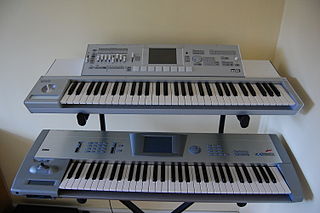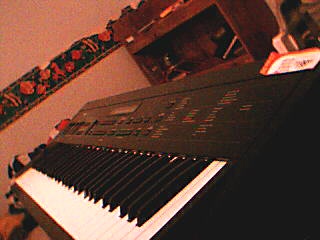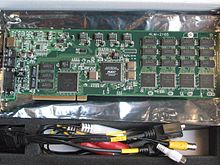
A digital synthesizer is a synthesizer that uses digital signal processing (DSP) techniques to make musical sounds, in contrast to older analog synthesizers, which produce music using analog electronics, and samplers, which play back digital recordings of acoustic, electric, or electronic instruments. Some digital synthesizers emulate analog synthesizers, while others include sampling capability in addition to digital synthesis.
Subtractive synthesis is a method of sound synthesis in which overtones of an audio signal are attenuated by a filter to alter the timbre of the sound.

An analog synthesizer is a synthesizer that uses analog circuits and analog signals to generate sound electronically.
Digital waveguide synthesis is the synthesis of audio using a digital waveguide. Digital waveguides are efficient computational models for physical media through which acoustic waves propagate. For this reason, digital waveguides constitute a major part of most modern physical modeling synthesizers.

The Korg Triton is a music workstation synthesizer, featuring digital sampling and sequencing, released in 1999. It uses Korg's "HI Synthesis" system and was eventually available in several model variants with numerous upgrade options. The Triton became renowned as a benchmark of keyboard technology, and has been widely featured in music videos and live concerts. At the NAMM Show in 2007, Korg announced the Korg M3 as its successor.

The Korg OASYS is a workstation synthesizer released in early 2005, 1 year after the successful Korg Triton Extreme. Unlike the Triton series, the OASYS uses a custom Linux operating system that was designed to be arbitrarily expandable via software updates, with its functionality limited only by the PC-like hardware.
An analog modeling synthesizer is a synthesizer that generates the sounds of traditional analog synthesizers using digital signal processing components and software algorithms. Analog modeling synthesizers simulate the behavior of the original electronic circuitry in order to digitally replicate their tone.

The microKORG is a MIDI-capable digital synthesizer/vocoder from Korg featuring DSP-based analog modelling. The synthesizer is built in such a way that it is essentially a Korg MS-2000 with a programmable step arpeggiator, a less advanced vocoder, lack of motion sequencing, lack of an XLR microphone input, and in a smaller case with fewer real-time control knobs.

The Korg Prophecy is a monophonic synthesizer released by Korg in 1995. one of the earliest commercial DSP physical/acoustic and analog "virtual" modeling sound synthesizers and Korg's first monophonic synthesizer since the Mono/Poly. The Prophecy employs Korg's Multi Oscillator Synthesis System (MOSS), which features digital oscillators capable of emulating synthesis techniques such as analog synthesis, FM and physical modelling. Emphasized for its portability, expressiveness, and engaging playability, a distinctive feature of the Prophecy is its multifunctional Wheel 3, nicknamed the 'log'.
The Korg Trinity is a synthesizer and music workstation released by Korg in 1995. It was Korg's first modern workstation and marked a significant evolution from its predecessors by offering features such as built-in digital audio recording, 32-note polyphony, an extensive internal sound library, assignable effects, and a large touchscreen for advanced control and editing functions, a feature not previously seen on any musical instrument. It also offered modular expansion for not only sounds, but also studio-grade features such as ADAT, various sound engine processors, audio recording capability, and more.
Synapse Audio Software is a software company located in Germany. Previously known as Sonic Syndicate and headed by Richard Hoffmann, they develop music production software for the Mac OS and Microsoft Windows platforms. They started developing software in November 1998 as Sonic Syndicate and changed their name to Synapse Audio with the release of Orion Platinum in 2002.
The Korg Polysix(PS-6) is a six-voice polyphonic analog synthesizer released by Korg in 1981. It was one of the first affordable polyphonic synthesizers on the market, and was released as a cheaper alternative to the Sequential Prophet-5 and Oberheim OB-X, priced at approximately a third of the cost of its contemporaries in the polysynth market. It includes one VCO per voice, enhanced by a chorus/ensemble effect for added richness. It also comes equipped with 32 program memories and an integrated arpeggiator.

The Korg Wavestation is a vector synthesis synthesizer first produced in the early 1990s and later re-released as a software synthesizer in 2004. Its primary innovation was Wave Sequencing, a method of multi-timbral sound generation in which different PCM waveform data are played successively, resulting in continuously evolving sounds. The Wavestation's "Advanced Vector Synthesis" sound architecture resembled early vector synths such as the Sequential Circuits Prophet VS.

A synthesizer is an electronic musical instrument that generates audio signals. Synthesizers typically create sounds by generating waveforms through methods including subtractive synthesis, additive synthesis and frequency modulation synthesis. These sounds may be altered by components such as filters, which cut or boost frequencies; envelopes, which control articulation, or how notes begin and end; and low-frequency oscillators, which modulate parameters such as pitch, volume, or filter characteristics affecting timbre. Synthesizers are typically played with keyboards or controlled by sequencers, software or other instruments, and may be synchronized to other equipment via MIDI.

The Korg DS-8 is a digital eight-voice FM synthesizer released by Korg in 1987. Following an agreement with Yamaha for access to its research and development facilities, it was designed using Yamaha components and constructed under a licensing agreement. It introduced an analog-style interface for controlling FM sounds and could play different patches on each of its eight voices, marking it as Korg's first multi-timbral MIDI synthesizer. Accompanying its launch was the Korg 707, a more portable version of the DS-8, lacking digital effects but equipped with strap pegs for keytar performance.

The Korg RADIAS is a virtual analog synthesizer and Vocoder, released by Korg in 2006. The RADIAS' MMT engine was based on the Korg OASYS synthesizer module, providing for several different synthesis methods, two of which may be combined in a single voice e.g. phase distortion synthesis can be combined with subtractive synthesis. The different synthesis methods employed by MMT represent the majority of methods used historically in other Korg synthesizers: digital waveguide synthesis Korg first used in the Korg Z1 and phase distortion synthesis was first used in the Korg DS-8. This flexibility allows for very realistic emulations of past Korg synthesizers, though stays away from trying to emulate the Korg M1 and the Korg Wavestation,. As well as using the in-built waveforms for the basis of sound creation, the RADIAS allows for the input of an external signal which may be routed through the various sound shaping devices. The RADIAS has a comprehensive matrix modulation specification and to further enhance a sound the 'Wave Shaper' module allows for various sound distortion effects.

The Kronos is a music workstation manufactured by Korg that combines nine different synthesizer sound engines with a sequencer, digital recorder, effects, a color touchscreen display and a keyboard. Korg's latest flagship synthesizer series at the time of its announcement, the Kronos series was announced at the winter NAMM Show in Anaheim, California in January 2011.

The Korg Z1 is a digital synthesizer released by Korg in 1997. The Z1 built upon the foundation set by the monophonic Prophecy released two years prior by offering 12-note polyphony and featuring expanded oscillator options, a polyphonic arpeggiator and an XY touchpad for enhanced performance interaction. It was the world's first multitimbral physical modelling synthesizer.
The Nautilus is a music workstation manufactured by Korg, a successor to Kronos 2, which comes with Kronos' nine different synthesizer sound engines and other similar features. It was announced in November 2020 with availability in January 2021.












